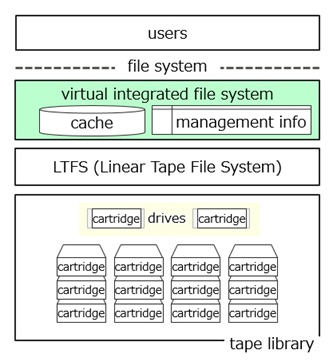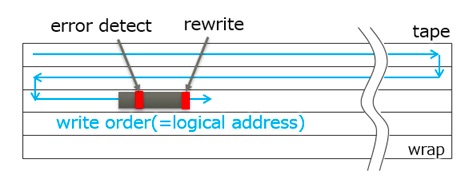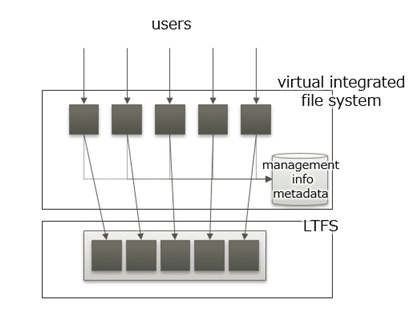|
Fujitsu Innovates Magnetic Tape Storage High-Speed Access Technology, Making Mass Data Archiving a Reality
Delivers 4.1 times higher read performance than previous models, offering greater versatility and range of uses for magnetic tape storage technology
KAWASAKI, Japan, Mar 03, 2020 - (JCN Newswire) - Fujitsu Laboratories Ltd. today announced the development of a breakthrough high-speed access technology for magnetic tape storage, which is attracting renewed interest as a low-cost, large-capacity storage solution alternative to hard disks (HDD).
 | | Fig.1 Configuration image of the developed system |
 | | Fig.2 Rewrite image on write error |
 | | Fig.3 Image of access order control with physical location |
 | | Fig.4 Multiple file aggregation image |
Traditionally, magnetic tape storage has been used mainly for backup purposes, but because of its high capacity and low cost, as well as the acceleration of transfer speeds and the spread of the Linear Tape File System (LTFS) in recent years, it is expected to find increasing use for archival purposes.
Fujitsu has successfully expanded the functionality of LTFS by innovating a unique file system that virtually integrates multiple tape cartridges. By improving random read performance from tape through data management and access order control in accordance with tape characteristics, the new technology successfully achieves speeds 4.1 times faster than conventional methods.
This technology will accelerate the adoption of magnetic tape storage technology as an archival medium in anticipation of the exponential growth of data in the future. By promoting this technology, Fujitsu will help companies to achieve their digital transformation goals through data storage solutions that offer superior performance at a reasonable cost. Fujitsu Laboratories is currently conducting a verification trial assuming the application of this technology to its operations, with plans to commercialize the technology by the end of fiscal year 2022.
Details of this technology will be presented at the 12th Forum on Data Engineering and Information Management (DEIM 2020), which will be held from March 2nd to March 4th.
About the Newly Developed Technology
While magnetic tape storage is ideally suited to reading from and writing to sequential areas of tape, its ability to randomly access discontinuous locations remains limited. The technology's relative inability to deliver random-access reading presents a roadblock to broadening its use into high volume data archiving applications.
In general, to manage a large amount of data with magnetic tape storage, data is held under a different directory for each tape cartridge on LTFS, which uses multiple tape cartridges and can access data on a file-by-file basis in the same way as data on HDDs, USB memory, etc.
Fujitsu developed a new file system on LTFS that virtually integrates multiple tape cartridges. This virtually integrated file system consolidates multiple tape cartridges into one, allowing users to access the data they need without thinking about each individual tape cartridge. In addition, the following newly developed technologies have been applied to this file system to achieve high-speed magnetic tape access performance.
1. Access Order Control with Physical Location
On magnetic tape, data is divided along its length in units called wraps, and each wrap wraps around and is written in a write-once fashion. Therefore, the distance between the logical address and the physical address is very different. The virtual consolidated file system accepts multiple random read requests and processes them starting with the closest physical location on the tape, not the logical address.
When writing to magnetic tape, write and error checking are performed in parallel, and when an error occurs, only the part of the error that occurred after the end of writing is automatically rewritten. Therefore, it is difficult to predict the physical location where a rewrite has finished from the change in file size. The physical location of each file is estimated by periodically measuring the head position after writing the file.
Also, when accessing the magnetic tape, it takes time to align the head to the start position. Therefore, two read requests that are close to each other on the same wrap will not read two files at once, but will read all the files in between and discard unnecessary files.
2. Multiple File Aggregation Function
LTFS maintains an index of each file on magnetic tape, and the impact increases exponentially as the number of files increases. When using tapes for archival purposes, users write and access files of various sizes, but writing large numbers of small files can significantly degrade read performance.
Therefore, Fujitsu has developed a mechanism to keep small files smaller than a specified file size together as large files on LTFS so that users can access them without worrying about the location of the files. In addition, by managing the metadata of user files in the virtual integrated file system, it is possible to quickly display a list in a way other than data reading, add extended attributes, or delete files without accessing the magnetic tape.
Outcomes
Fujitsu has constructed a hierarchical storage system for HDDs and magnetic tapes by using Ceph(1), an open-source distributed storage software, and evaluated the access performance of the system. As a result, the time required to read 100 files randomly from a total of 50,000 individual 100 MB files stored on magnetic tape was 5,400 seconds with the conventional method. By using the new technology, it was possible to confirm a read in 1,300 seconds, which is 4.1 times faster than the conventional method. In addition, while the conventional method required 2.5 seconds to move 256 individual 1 MB files on the HDD onto magnetic tape, the new technology enabled us to confirm data movement in 1.3 seconds, which is 1.9 times faster than the conventional method.
This technology enables high-speed tape access performance, such as random reads and writes of various sizes occurring in archive applications, and is expected to provide a cost-effective data archiving infrastructure for long-term archiving of large volumes of data.
(1) Ceph Open source distributed storage software developed at the University of California and managed by the Ceph community since 2004.
About Fujitsu Laboratories
Founded in 1968 as a wholly-owned subsidiary of Fujitsu Limited, Fujitsu Laboratories Ltd. is one of the premier research centers in the world. With a global network of laboratories in Japan, China, the United States and Europe, the organization conducts a wide range of basic and applied research in the areas of Next-generation Services, Computer Servers, Networks, Electronic Devices and Advanced Materials. For more information, please see: http://www.fujitsu.com/jp/group/labs/en/.
Fujitsu Laboratories Ltd.
Platform Innovation Project
E-mail: data-archive@ml.labs.fujitsu.com
Source: Fujitsu Ltd
Sectors: Electronics
Copyright ©2024 JCN Newswire. All rights reserved. A division of Japan Corporate News Network. |
Latest Release

First-ever Mazda CX-80 Crossover SUV Unveiled in Europe
Apr 19, 2024 13:50 JST
| 
Fujitsu develops technology to convert corporate digital identity credentials, enabling participation of non-European companies in European data spaces
Apr 19, 2024 10:17 JST
| 
Mitsubishi Heavy Industries and NGK to Jointly Develop Hydrogen Purification System from Ammonia Cracking Gas
Apr 18, 2024 17:01 JST
| 
Toyota Launches All-New Land Cruiser "250" Series in Japan
Apr 18, 2024 13:39 JST
| 
Fujitsu and Oracle collaborate to deliver sovereign cloud and AI capabilities in Japan
Apr 18, 2024 11:14 JST
| 
Eisai: Research on Treatments for Alzheimer's Disease Based on Its Pathological Mechanisms Recieves Award for Science and Technology (Research Category)
Apr 18, 2024 10:53 JST
| 
All-New Triton Confirmed as First Double-Cab Pickup Truck to Achieve 2024 Five-Star ANCAP Safety Rating
Apr 18, 2024 09:22 JST
| 
Eisai's Antiepileptic Drug Fycompa Injection Formulation Launched In Japan
Apr 17, 2024 16:17 JST
| 
Honda Unveils Next-generation EV Series for China
Apr 17, 2024 12:15 JST
| 
Lexus presents Time at the 2024 Milan Design Week
Apr 16, 2024 18:49 JST
| 
Mitsubishi Corporation Announces Participation in a DAC Project in Louisiana, USA
Apr 16, 2024 14:36 JST
| 
New circuit challenge for TOYOTA GAZOO Racing
Apr 15, 2024 17:21 JST
| 
TOYOTA GAZOO Racing back on asphalt for Croatian challenge
Apr 12, 2024 19:36 JST
| 
Heidelberg Materials North America Announces Latest Milestone in Edmonton CCUS Project
Apr 12, 2024 14:39 JST
| 
MHIAEL Completes Expansion of the its Nagasaki Plant for Manufacture of Aero Engine Combustors
Apr 11, 2024 18:08 JST
| 
Mitsubishi Shipbuilding Acquires Approval in Principle (AiP) from Classification Society ClassNK for Ammonia Fuel Supply System (AFSS)
Apr 11, 2024 17:50 JST
| 
DOCOMO, NTT, NEC and Fujitsu Develop Top-level Sub-terahertz 6G Device Capable of Ultra-high-speed 100 Gbps Transmission
Apr 11, 2024 15:10 JST
| 
Mitsubishi Corporation Announces Completion of Capital Raise by Nexamp
Apr 11, 2024 13:07 JST
| 
Mitsubishi Shipbuilding Receives Order for Ammonia Fuel Supply System for Ammonia-Powered Marine Engine
Apr 10, 2024 16:55 JST
| 
Transgene and NEC Present First Clinical Benefits of Neoantigen Cancer Vaccine, TG4050, in Head & Neck Cancer at AACR 2024
Apr 10, 2024 13:36 JST
|
More Latest Release >>
|